DoorBird finds itself competing for the top spot in the video doorbell market. While one of the top contenders, Ring, continues to make improvements, DoorBird is quietly keeping pace. So how does the DoorBird video doorbell compare to Ring 2? We aim to find out.
This article will cover what the two doorbells do differently, how they are the same, and then compare each feature and aspect on a one on one situation. We go on to find out which is the better doorbell for you. If you are short on time, pick up the Ring Doorbell 2. It is our recommendation in this comparison. Read on to find out why.
Contents
- 1 Differences between Ring and DoorBird
- 2 Similarities between Ring and DoorBird
- 3 Specifications Chart
- 4 Comparing the Doorbird Vs. Ring
- 4.1 Can You Install Yourself?
- 4.2 How to Install the DoorBird and Ring 2 Video Doorbells
- 4.3 Various Power Options To Meet Your Needs
- 4.4 Integration With Smart Home Features
- 4.5 Cloud Storage Works for Both Models
- 4.6 Viewing the Video Feeds and Two-Way Communications
- 4.7 Motion Zones and Alerts
- 4.8 Night Vision
- 5 Alternative Options
- 6 What I Like About Ring 2
- 7 What I Like About DoorBird
- 8 Conclusion
Differences between Ring and DoorBird
There are several things that the two models will do differently. While aesthetics and options may be similar, let’s take a look at where the Ring 2 and DoorBird differ.
- Power over Ethernet. PoE is a common standard for computer devices that connect to the internet. The DoorBird has the option to use PoE while the Ring 2 does not.
- Live on Demand. The DoorBird brings you the ability to stream the view of your video doorbell whenever you like. Ring 2 does offer the feature, but there are a few prerequisites to go through first.
- Recording Resolution. DoorBird records in 720p HD, while the Ring 2 records in 1080p HD.
- Field of View. It can be understated; however, the field of view in both horizontal and vertical aspects is important. The Ring 2 has a 140-degree vertical FoV while the DoorBird has a limited 90 degrees vertical.
- Battery power. The Ring 2 has an optional rechargeable battery power source that the DoorBird doesn’t offer.
- Free cloud storage. In short, the DoorBird has a free storage option that the Ring 2 doesn’t give you.
- Color options. The Ring 2 is designed to fit with more décor options giving you four colors to choose from. DoorBird only has 2 color options.
Similarities between Ring and DoorBird
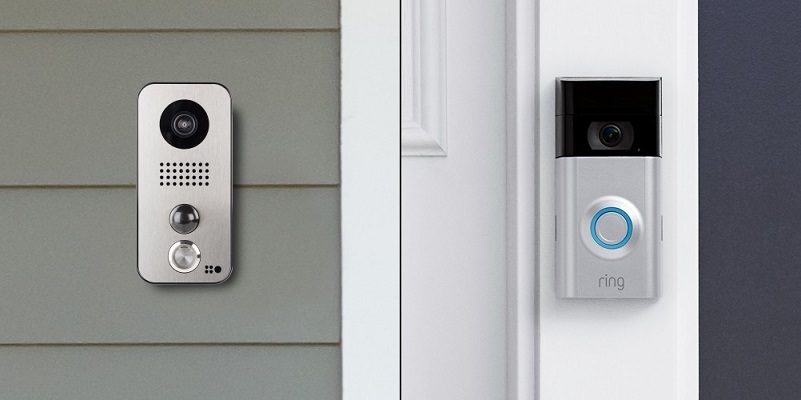
Both Ring 2 and DoorBird bring you a lot of similar technology and features. Let’s cover those basic similarities now.
- Wireless communications. Each of the video doorbells is compatible with the 2.4gHz wireless networks.
- Night vision. You will be able to see at night with the night vision modes of both devices.
- Two-way communications. Each video doorbell allows you to see, talk to, and hear whoever is at your door.
- Both doorbells take up about the same amount of space on your wall.
- Cloud services. Aside from the free option from DoorBird, both models offer you a cloud storage option.
- Smart Home integration. You can use Amazon Alexa enabled devices (video) to view the live feeds of both devices.
Specifications Chart
Now we get to see the two doorbells side-by-side to get a better idea of the features offered by both the DoorBird and Ring 2.
| Ring 2 | DoorBird D101 | |
| Dimensions | 5×2.5×1.08 inches | 6.2×2.9×1.4 inches |
| PoE | No | Yes |
| Mobile App | Yes | Yes |
| WiFi Connection | Yes (2.4gHz) | Yes (2.4gHz) |
| Two-Way Communication | Yes | Yes |
| Video Resolution | 1080p | 720p |
| Field of View | 160×140 degrees | 180×90 degrees |
| Motion Zones | Yes | Yes |
| Live View | Yes (Hardwired only) | Yes |
| Cloud Storage | Separate purchase only | Yes, upgrades (purchase) available |
| Chime | Yes | Yes |
| Dual Power Option | Hardwired or Battery | Hardwired or PoE |
| Night Vision | Yes | Yes |
| Faceplate Colors | Four | Two |
| Operation Temperatures | -5 to 120 degrees (F) | -4 to 140 degrees (F) |
| Warranty | 1-Year warranty, Lifetime Theft Protection | 2-Year limited warranty |
| Price | Check on Amazon | Check on Amazon |
Comparing the Doorbird Vs. Ring
Starting with the DIY installation, let’s take a look at how the two models compare to each other on various stand-out factors. Even though we pick a “winner” based on the comparison, you may find that certain features are not as relevant to you, and decide to side with the “loser.” There is no right or wrong; the objective is to determine the best video doorbell for your needs.
Can You Install Yourself?
Both the DoorBird and Ring 2 offer you multiple installation options and a fairly straightforward installation procedure. Each one is marketed and designed for a DIY install. However, before you buy, you need to consider professional installation.
For the vast majority of us, a DIY install works just fine. However, if you do not have a current doorbell or interior chime, you may want to hire a professional. Why? Both the DoorBird and Ring 2 have hardwired options. These are the preferred method of installing, and each is made to connect to your existing doorbell wiring.
If you do not have existing wiring, you will need to run some, which can include a power supply to a breaker panel, installing a chime, drywall removal, and replacement, etc. At a minimum, you will need to drill holes from the exterior of your home to the interior.
If you aren’t comfortable with these installation requirements, a professional should be called. According to Home Advisor, a home automation system (starting with a video doorbell) can range from $297 to $1,578. If you are installing the video doorbell only, the cost will be much lower.
How to Install the DoorBird and Ring 2 Video Doorbells
Both companies provide DIY instructions and include everything you need to install the doorbells properly. As a short guide to let you know what you are getting yourself into, here are the basic steps for both models needed for a standard hardwired installation. Keep in mind, these instructions are not definitive and assume you have an existing doorbell and chime.
- Unpack the contents of the box and verify all items are included.
- Cut the power to the chime, usually found in the breaker control panel.
- Remove the existing doorbell and inspect the wires from the chime for damage.
- Run the power cord through the wall from the outside in. Cut a larger hole or a through-hole is it isn’t large enough or doesn’t go all the way through.
- Pull the wires and power through the junction box from the back and install the junction box that holds the doorbell.
- Plug the wires into the corresponding ports to supply power and chime to the doorbell. Secure the doorbell to the junction box.
- Download and install the respective mobile app, creating your account or signing in to an existing one.
- Supply power to the doorbell and follow the mobile app instructions to connect it to the wireless network.
- Finish setup through the app and verify the video and chime work.
- Select your faceplate and install it over the doorbell.
Of course, depending on the model, and how you will have it powered (battery for the Ring 2 or PoE for the DoorBird), the installation will be slightly different. Refer to the owner’s manual or the mobile app for further instructions.
Bottom Line: Both models tie here. Installation can vary in difficulty based on existing doorbells, power supply options, and DIY skill.
Various Power Options To Meet Your Needs
I have mentioned a few times the various power supply options. Let me cover them in more detail here.
- Both the DoorBird and Ring 2 have hardwired capabilities. This will require you to use a junction box and run a power cord to either an outlet or through existing power wires.
- Power of Ethernet. This power option is exclusive to DoorBird. Instead of a power cord, you will run an Ethernet cable directly from your modem or router. Not only will the doorbell have a power supply, but it will also not need wireless communications to store video on the cloud.
- The Ring 2 offers a battery power option that allows you to mount the doorbell without running any wires or cutting holes in your walls. The battery pack is rechargeable and will last, on average, between three and six months per charge.
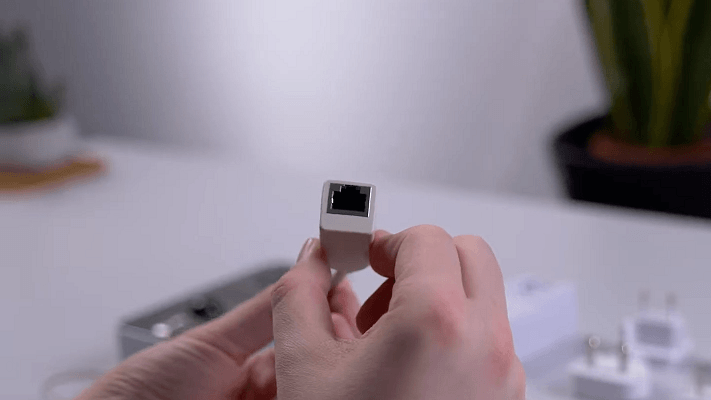
Bottom Line: This is a tie as well. Both offer the hardwired options. Ring 2 gives you the installation ease of battery power, while the DoorBird has the convenience of PoE.
Integration With Smart Home Features
There are several integration systems with both the DoorBird and Ring video doorbells. Your existing setup and integration methods may prove to be the deciding factor here.
Ring has limited compatibility with Google Assistant. You won’t be able to view the streaming video through Chromecast or connect the Ring 2 with the Google Hub or Google Mini. The best option is through Amazon Alexa devices.
With Ring 2 and Amazon, you can view the video feed (FireTV, Fire Tablet, Echo Show), as well as use Alexa skills to start a recording, review the cloud storage (if subscribed), and other features.
You can also control Schlage and Kwikset door locks with the Ring 2 as long as you use the Z-Wave wireless connections. There is also integration updates for further implementation with Lockstate, Kisi, or Lockitron systems as well.
DoorBird has other plans. They are working on getting compatible with Amazon Alexa devices, but as of this writing, nothing is working yet. There is also limited, if any, compatibility with Google Assistant or Home devices. Some users do get Google to work using the DoorBird API; most others do not.
The DoorBird will integrate with many other systems (over 40 and counting). However, most of the integrations are for the DoorBird IP control door station. You can see the complete list of connected devices and brands here. Note: Since DoorBird is a German company, the primary focus for connectivity is with European brands at the moment.
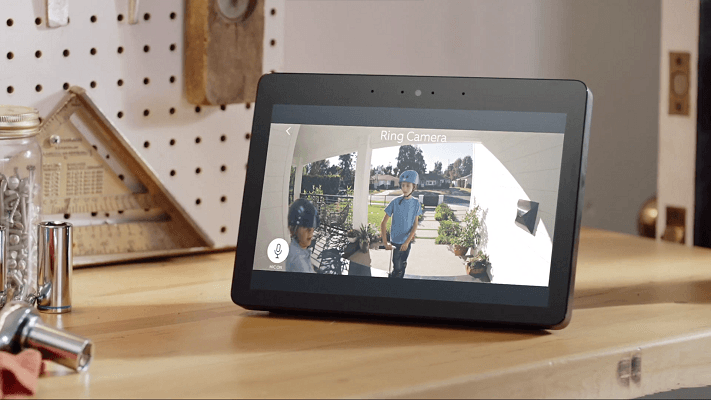
Bottom Line: Ring 2 wins unless you are in Europe. Amazon Alexa is currently the most comprehensive connection, and only Ring has it. DoorBird is expected to catch up soon, though.
Cloud Storage Works for Both Models
If you want to review your recordings, make a copy to send to neighbors or the police, or just want to see what happened while you were away, you need cloud storage.
DoorBird offers a free history of the 50 most recent events. The events consist of both still images and recordings. You can download the events to your smartphone or tablet with the mobile app, but the stored images are in standard VGA definition.
You can purchase Cloud Recording Pro, which will upgrade the resolution to 720p HD, allow for unlimited events, and comes with a 7-day turnover. The cost of Cloud Recording Pro is $53 per year for one DoorBird doorbell.
Ring handles things a little differently. Unlike the DoorBird, you cannot view the live streaming unless the Ring 2 is hardwired. They do not offer a free storage service, either. If you want to review recordings or download events, you must subscribe to their Cloud Storage services.
There are three tiers of service, Free, which is included with each Ring device, Basic and Protect. Here is a breakdown of the different plans.
| Free | Basic | Protect | |
| Coverage | The single item | One Ring device | All Ring devices at a single address |
| Alerts | Yes | Yes | Yes |
| Custom Motion Detection | Yes | Yes | Yes |
| World-Wide Two-Way Communication | Yes | Yes | Yes |
| Video on Demand (live) | Yes | Yes | Yes |
| Warranty | 1-year | 1-year | 1-year Extended (after 1-year warranty remains as long as you subscribe to this plan) |
| Video Recording Storage | No | Every event for up to 60 days | Every event for up to 60 days |
| Review, Save, and Share Events | No | Yes | Yes |
| Snapshot | No | No | Yes (7-day rollover) |
| Professional Monitoring | No | No | Yes (US only) |
| Contact | No | Monthly, Cancel any time | Monthly, Cancel anytime |
| Ring.com discounts | No | No | 10% all ring.com purchases |
| Price | Free | $3/month $30/year for each Ring device | $10/month $100/year all Ring devices at a single address. |
Further, Ring offers a lifetime replacement of your Ring 2 if it is ever stolen. This includes the Free version and will cover the device as long as you own it, regardless of subscription.
Bottom Line: Ring 2 wins. Even with the lack of storage for the Free plan, cloud storage itself is much more detailed, economical and complete versus the DoorBird plans.
Viewing the Video Feeds and Two-Way Communications
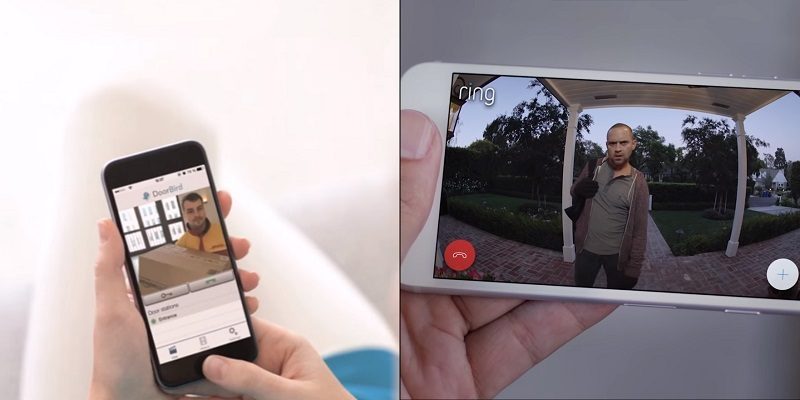
Almost all of the viewing will come via the mobile apps that you install on your smartphone or tablets. Both Ring and DoorBird give you these options. Remember, though, that with Ring, you must have the doorbell hardwired in order to view live streaming.
Ring offers you another way to view your live feed, though. Through Amazon Alexa, you can have the live view brought up on your Echo Show, Fire TV, or television connected with a FireTV stick.
Both models have a speaker and a microphone built-in. This enables you to communicate with whoever is at your door. When the motion alerts go off, you will get a notification on your phone, where you can then enable communications.
Once enabled, you will be able to hear the visitor as well as talk to them through the mobile apps. Ring further allows the communications to go through the Alexa connected devices, so you will speak through your Alexa device and see the video feed as well as hear the responses.
For example, you can talk through the mobile app, while watching the feed and hearing the visitor speak through your television.
Bottom Line: Ring 2 wins. With more ways to view and communicate, the winner is obvious.
Motion Zones and Alerts
The two doorbells are pretty equal when it comes to alerts and motion zones. Through the two mobile apps, you will be able to set up motion zones that will spark recordings or initiate communications.
Motion zones allow you to help negate false positives by blocking out areas that aren’t actual people. The street, a blowing tree branch, or other areas that can trigger a false alert, can be essentially removed.
Once you have your motion zones set up, the Ring 2 and DoorBird will only send you alerts and notifications when there is perceived movement in the active zones.
Both models use what is known as PIR responses or Passive Infrared responses. Basically, the doorbells recognize heat signatures using infrared to determine if something is moving in front of the camera.
Once movement is identified, the alerts are sent, and recording begins.
Bottom line: This is a tie. Both doorbells use PIR algorithms and have customized motion zones.
Night Vision
Both the Ring 2 and DoorBird have night vision capabilities. Using infrared lighting, the two doorbells can see relatively clearly in low-light situations. While the images are black and white, the clarity is still enough to identify who is standing there.
Ring 2 does have color night vision, but I hesitate to say it is working great. A lot will depend on your mounting location, ambient lighting, and how dark it is outside. There needs to be enough light, so the LED infrared bulbs can pick up the colors. However, too much direct light will cause them to glare and produce a black and white image.
For the most part, the color option is nice when it works, but it isn’t the end-all-be-all. The black and white images are still crystal clear and will even record in 1080p.
Bottom Line: This is a tie. While the Ring 2 supports color night vision, don’t be surprised if it doesn’t always work.
Alternative Options
If you want more (or less) features and options, both DoorBird and Ring have other doorbells for you to consider. Below is a quick rundown of the other video doorbell variations.
DoorBird Alternatives
The DoorBird D101 is an attractive and self-sufficient doorbell. However, if you are looking for more, the DoorBird offers the D2101 model. This will give you a keypad and a call button, which will work as an intercom. It has a flush-mount option, and you can even add-on more call buttons.
There is also the D21DKV, which is similar to the D2101 models but comes with a display screen as well. Both models are upgrades to the D101 and are the models that DoorBird is working on upgrading more into the future.
Ring Alternatives
[easyazon_image align=”none” height=”260″ identifier=”B00N2ZDXW2″ locale=”US” src=”https://smartrobotichome.com/wp-content/uploads/2019/12/41NqOp9cCsL-1.jpg” tag=”srh-easyazon-20″ width=”260″]
[easyazon_image align=”none” height=”500″ identifier=”B071DZYTKY” locale=”US” src=”https://smartrobotichome.com/wp-content/uploads/2019/12/31KJjiqdvwL-1.jpg” tag=”srh-easyazon-20″ width=”500″]
Ring has a few variations, and as you probably guessed by the name, the Ring 2 isn’t the first model. The original Ring video doorbell is selling for a much lower price now but is limited in its options. Even with the lower price, it isn’t advised to go with this model.
However, if you are looking for an upgrade, the Ring Pro allows you to view the live stream at all times, can connect to 2.4 or 5gHz wireless networks, and uses advanced motion detection algorithms instead of PIR.
For even more, the Ring Elite is almost identical to the Ring Pro except that is does have a PoE option for connectivity. If you are looking for a Ring and want PoE, the Elite is your only option.
What I Like About Ring 2
- Hardwired or battery power install options.
- Ring cloud services are complete and affordable.
- Lifetime theft protection isn’t offered anywhere else.
What I Like About DoorBird
- Many integrations, including almost every smart lock.
- PoE option for those that don’t want to tie up wireless networks.
- Can view live stream even without cloud services.
Conclusion
When it comes to security, the first line of defense is your front door. Gone are the days of relying on a peephole or yelling through a closed door. With the DoorBird and Ring video doorbells, you can see and communicate with anyone at your door right from your phone or tablet.
While both models offer you various integrations, support, and cloud services, the better option right now, falls with Ring. Even though you are all but required to subscribe to the cloud services, the Ring 2 works well with Amazon devices and comes with a lifetime theft replacement option. The Ring 2 is our pick for the best video doorbell in this comparison.
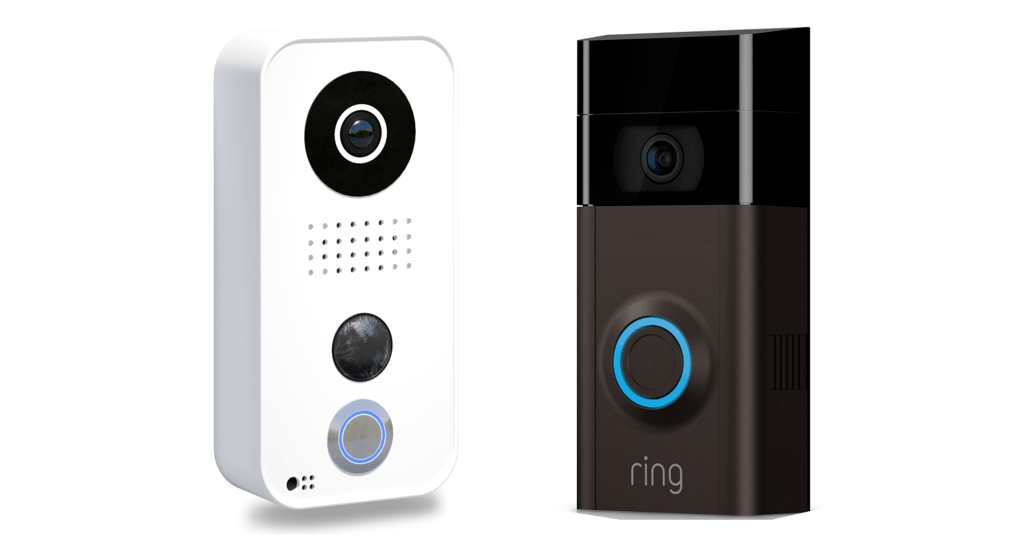
One of the major points that pushed me towards the DoorBird options was the ability to integrate with local storage. I have my DoorBird set up so that it records to a NAS (Synology) and I can maintain a very long retention policy on the video. This also enables me to do things like recording 24/7, rather than just motion activated.